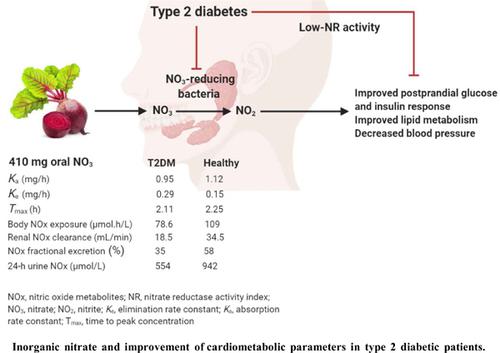Endocrine, Metabolic & Immune Disorders - Drug Targets ( IF 2.0 ) Pub Date : 2021-05-01 , DOI: 10.2174/1871530320666200813135251 Zahra Bahadoran 1 , Parvin Mirmiran 2 , Mattias Carlström 3 , Reza Norouzirad 4 , Sajad Jeddi 5 , Fereidoun Azizi 6 , Asghar Ghasemi 5

|
Aim: In this study, we aimed to compare the pharmacokinetics of nitrate (NO3) in patients with type 2 diabetes mellitus (T2DM) and healthy adults. Potential effects of salivary nitrate reductase (NR) activity on cardiometabolic responses to an acute dose of NO3 was also assessed.
Methods: Nine healthy adults and nine T2DM patients were recruited to consume a NO3-rich breakfast (~410 mg NO3). Pharmacokinetics of NO3 were examined using repeated measurements of NOx (nitrate+ nitrite) concentrations of serum and saliva over 8 hours and NO3 concentrations of spot and 24-h urine samples. Cardiometabolic parameters, including serum levels of glucose, insulin, and triglycerides as well as blood pressure were also measured.
Results: Compared to patients with T2DM, serum NOx concentration (Δ1= 16.7 vs. 4.4 μmol/L, P=0.057) of healthy subjects sharply increased within 1 hour after NO3 loading. Healthy subjects had a higher NR activity index, and higher peak salivary NO3 concentration with a lower time to peak. Diabetic patients with high- compared to low-NR values had a higher whole-body NOx exposure (103±31.4 vs. 58.9±22.1 μmol.h/L); they also showed a better glycemic response and more reduction of blood pressure following ingestion of a NO3-rich meal.
Conclusion: T2DM may be associated with a different pattern of NOx pharmacokinetics (especially salivary NOx metabolism). Salivary NR activity may have a critical role in postprandial metabolism of NO3, and diabetic patients with higher NR activity may take more advantages from NO3 supplementation.
中文翻译:

2型糖尿病患者对急性剂量无机硝酸盐的不同药代动力学反应
目的:在这项研究中,我们旨在比较2型糖尿病(T2DM)患者和健康成年人中硝酸盐(NO 3)的药代动力学。还评估了唾液硝酸还原酶(NR)活性对急性剂量NO 3的心脏代谢反应的潜在影响。
方法:招募9名健康成年人和9名T2DM患者食用富含NO 3的早餐(〜410 mg NO 3)。通过在8小时内重复测量血清和唾液中NOx(硝酸盐+亚硝酸盐)的浓度以及现场和24小时尿液样本中NO 3的浓度,来检查NO 3的药代动力学。还测量了心脏代谢参数,包括血清葡萄糖,胰岛素和甘油三酸酯的水平以及血压。
结果:与2型糖尿病患者,血清NOx浓度(Δ 1健康受试者的= 16.7与4.4微摩尔/ L,P = 0.057)后急剧NO 1小时内增加3加载。健康受试者的NR活性指数较高,唾液中NO 3的峰值浓度较高,而到达峰值的时间较短。高NR值与低NR值的糖尿病患者全身NOx暴露较高(103±31.4 vs. 58.9±22.1μmol.h/ L);摄入富含NO 3的食物后,他们还表现出更好的血糖反应和更多的血压降低。
结论:T2DM可能与NOx药代动力学的不同模式(尤其是唾液NOx代谢)有关。唾液NR活性可能在餐后NO 3代谢中起关键作用,而具有较高NR活性的糖尿病患者可能会从NO 3补充中获得更多好处。











































 京公网安备 11010802027423号
京公网安备 11010802027423号